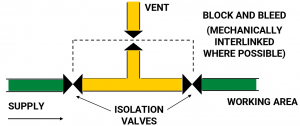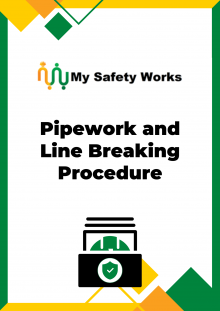Description
What is Pipework and Line Breaking?
Pipework is a term used (mainly in the oil and gas industry) to refer to a system of pipes that are used to transport fluids (usually hydrocarbons) from one location to another.
Line breaking is a procedure that is used to safely and effectively disconnect two sections of pipe so that they can be reconnected later on after repair or maintenance work has been completed.
What is Pipework and Line Breaking Procedure?
A pipework and line breaking procedure is a written document that is used to describe the requirements for isolation of pipework and line breaking.
The intent of the procedure is to eliminate or reduce the risk of harm to personnel when undertaking pipework and line breaking tasks and meet all the requirements of legislated obligations.
Typical Procedure for Pipework Isolation and Reconnection

Block and Bleed System for Pipework Isolation
A typical procedure for isolation includes steps for:
- Identifying the pipework and checking you have the correct pipework.
- Isolating the section by shutting and locking stop valves and breaking mechanical joints.
- Purging, if necessary, and discharging the purge.
- Ensuring you have checked piping and instrumentation diagrams (P&ID’s).
- Appropriate signage and barriers should be used.
- Ensure the appropriate personal protection equipment (PPE) is worn to protect against the potential gases and liquids in the pipework.
- After isolation, the work can be completed, and the supply re-connected after completion of the work.
Contents of this Pipework and Line Breaking Procedure
- Approval.
- Purpose.
- Scope.
- Terms and Definitions.
- Roles and Responsibilities.
- Procedures.
- Overview.
- Typical Procedure for Pipework Isolation and Reconnection.
- Preference Order for Methods of Isolation.
- Isolation Method 1 – Removal of Pipework.
- Procedure for Using Method 1 – Removal of Pipework.
- Isolation Method 2 – Insertion of a Blank.
- Procedure for Isolation Using Method 2 – Insertion of a Blank.
- Procedure for Reconnection Using Method 2 – Insertion of a Blank.
- Isolation Method 3 – Block and Bleed System.
- Isolation Method 4 – Locked Stop Valve and Continuous Purge.
- Isolation Method 5 – Stop Valve, No Continuous Purge.
- Isolation Method 6 – Pipe-freezing.
- Principles of Purging.
- Related Procedures, Forms and Documents.
- Review Criteria.
- Record Management.
- References.
Why Choose to Buy this Pipework and Line Breaking Procedure
This 11-page procedure can assist you manage the risks to personnel when undertaking pipework and line breaking tasks and meet the requirements of legislated obligations.
After purchasing this procedure you will be able to:
- Very easily edit and customize the template to create your own procedure.
- Apply your own style, format and brand to the procedure.
- Use it in any industry or sector regardless of the size or type of organization.
Availability and Use of this Pipework and Line Breaking Procedure
- This procedure is accessible to you right now by clicking the ‘Buy Now’ button.
- The procedure will be delivered to you in fully editable Microsoft Word format for immediate and full use in your business.
- There are no subscriptions, contracts or ongoing costs.

This pipework and line breaking procedure is 100% satisfaction guaranteed.
You may also require:


